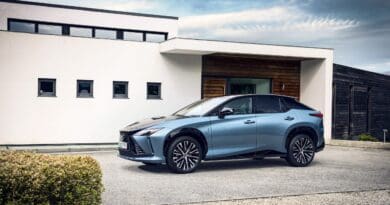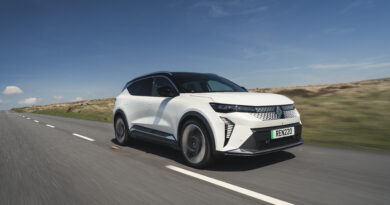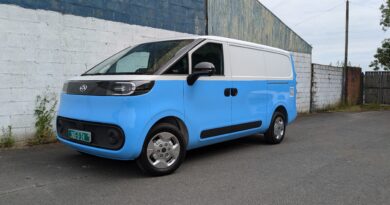NIO ET7 Review: Is this the Tesla killer?
In EV Powered’s latest review, Charlie Atkinson travels to Gothenburg, Sweden to test out the fully electric NIO ET7.
The arrival of Chinese electric cars in Europe is seen as the ‘next step’ for the EV movement and with the NIO ET7, the game could be changed forever.
This fully electric saloon from Chinese auto-giants NIO combines a truly solid EV option for a relatively affordable price, making it potentially the toughest competition for EV-kingpins Tesla.
In this review, I’ll tell you everything there is to know about the NIO ET7 and why it could change the landscape of electric vehicles for good.
Design
From the outset, there are a lot of similarities between the NIO ET7 and all of the Tesla models and, in fact, NIO is often called the ‘Chinese Tesla’ and it’s clear to see why.
This particular model positions itself alongside the Tesla Model S and it shares certain elements of its design language, including the razor thin LED-beam headlights and the smaller headlamps underneath.
The profile of the car is almost an exact copy of the Model S, although the NIO ET7 is slightly longer, which translates into extra space for the interior. The ET7 is longer than most of its competitors, which also includes the ultra-premium Mercedes EQS.
Around the car, you will find hidden door handles at the side and a sloping roof that glides into the full light bar at the rear, which is the hallmark of all new electric vehicles.
Front on, you will also notice some of the 33-different cameras above the windscreen, as well as the LiDAR sensor, which, due to its central position, makes the car look a little bit like a black cab.
Interior
It may share some sort of resemblance to the Model S from the outside, but the interior of the ET7 is where it is most similar to the Tesla.
Your attention is immediately drawn to the 12.8” infotainment screen in the centre of the cabin, which is where you control 99% of the car’s functions from, including air conditioning, driving modes and other customisable settings.
Unlike the Tesla, though, the ET7 does have a smaller drivers display, which offers basic information such as speed and navigation, as well as a heads-up display.
In the cockpit, you also have wireless charging for your phone, and plenty of storage, including this middle compartment which conveniently opens both ways. There are also a few physical buttons which control things such as your hazards for example, but for the most part, everything is controlled through this centre screen or through NOMI, your animated virtual assistant that can answer all of your questions and perform certain tasks for you, such as turning on the heating or massage settings for your 4-way adjustable seats with perforated artificial leather.
The interior of the car and all the different furnishings feel high-quality and well put together, which isn’t always the case for Tesla.
In the back, you have a split panoramic sunroof and, because of the dimensions of the car, plenty of legroom, too. Taller passengers may struggle for headroom in the back due to the roofline, but there is still more than enough space to get comfortable.
Passengers in the back also have their own touchscreen which can control air conditioning and the music in the car. There is also an option to fold the front passenger seat down (if nobody is sat in it) so you can stretch your legs all the way out. The boot also offers plenty of storage with 364 litres of storage space.
Driving
The headline statistic for the NIO ET7 is the claimed 1,000km range, but there is a bit of a catch with that. That 1,000km range is based on the China Light-Duty Vehicle Test Cycle, and that will only apply to the 150Kw version of this vehicle, which will be released later this year.
With the 100kW version I tested, the ET7 offers a range of 360 miles in the long-range spec, and 276 miles in the standard model according to the WLTP system. It is a healthy range, but it doesn’t quite compete with the Tesla.
However, NIO does have a trick up its sleeve. Tesla may have its Supercharger network, but NIO is quickly rolling out its Power Swap Station’s (PSS) across Europe. These sites, which NIO drivers can subscribe to, allow you to swap your battery for a new, fully charged one in just five minutes. This system, which we saw first-hand in our trip to Gothenburg, changes the game for electric vehicle charging, and you can see the NIO PSS in action on our YouTube channel here.
Once you’re fully charged and back out on the road, you will be able to make use of the NIO ET7’s performance, which offers a 0-60mph time of just 3.8 seconds in Sport+ mode. The acceleration is frightening, and launching this car quickly becomes addictive.
When you’re not blasting this car around, however, you will be able to enjoy the peaceful driving experience that the NIO ET7 offers. It is smooth, balanced and handles well in all types of environments and, thanks to its double layered glass windows, road and wind noise is dramatically reduced to create a nice and calm atmosphere behind the wheel.
The ET7 is also ready for the future thanks to its autonomous driving capabilities. With the 33 different sensors mounted all around the car, the ET7 can detect road conditions in advance which will automatically adjust the suspension to make the ride as smooth and comfortable as possible. Those high-performance sensing units give the car 360 vision, and it also has 8 MP Autonomous Driving High-Resolution Cameras that can see everything up to 500m in the distance.
In addition to this, the ET7 has achieved a 5-star safety rating from NCAP and, in case you are involved in any accidents, the car has a built-in dashcam system that records each journey from different angles.
Overall, the NIO ET7 is a joy to drive. It is comfortable and relaxing, with the capability of putting a great big smile on your face when you put your foot down.
Verdict
The emergence of Chinese brands in Europe is the moment many have been waiting for. With brands like NIO, and with cars like the ET7, you have a properly premium product that is just as good and substantially cheaper.
If we compare the ET7 to one of its biggest competitors, the Mercedes EQS, you will see that the ET7 offers a similar range, design and level of performance, but for about £15,000 cheaper.
Unfortunately for our UK audience, you won’t be able to get your hands on one of these just yet, but they should be available for order by the end of this year, and I expect there’s going to be quite the demand for these things.
With its great range, amazing performance, and a stylish interior with all the tech, comfort and storage you could want, the NIO ET7 has justified itself as one of the best electric vehicles around, and NIO as a brand, has given other EV manufacturers a lot to think about.






